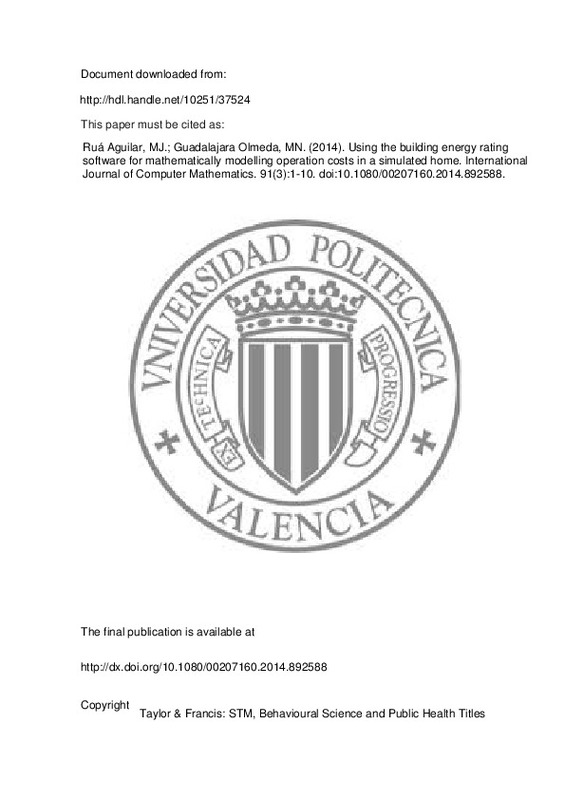JavaScript is disabled for your browser. Some features of this site may not work without it.
Buscar en RiuNet
Listar
Mi cuenta
Estadísticas
Ayuda RiuNet
Admin. UPV
Using the building energy rating software for mathematically modelling operation costs in a simulated home
Mostrar el registro sencillo del ítem
Ficheros en el ítem
| dc.contributor.author | Ruá Aguilar, María José
|
es_ES |
| dc.contributor.author | Guadalajara Olmeda, María Natividad
|
es_ES |
| dc.date.accessioned | 2014-05-16T13:00:13Z | |
| dc.date.issued | 2014-03-27 | |
| dc.identifier.issn | 0020-7160 | |
| dc.identifier.uri | http://hdl.handle.net/10251/37524 | |
| dc.description | This is an Accepted Manuscript of an article published by Taylor & Francis Group in International Journal of Computer Mathematics on 27 March 2014, available online at: http://www.tandfonline.com/10.1080/00207160.2014.892588. | es_ES |
| dc.description.abstract | The building industry is becoming very important in sustainable development. The recently developed policies in European Union directives on energy and their transposition to Spanish regulations make the Energy Performance Certification process for buildings mandatory. Two software tools have been developed in Spain to carry out this process: Lider and Calener. These software tools have been used in this paper to simulate energy performance in new semidetached houses after taking into account the thermal envelope of the building and facilities. This has been done in different climatic zones in Spain and for all the possible energy ratings. Based on the energy rating and construction cost variables, it has been possible to obtain mathematical models that explain the behaviour of global costs of buildings based on energy ratings and climatic zones. Depreciation costs, maintenance costs, energy consumption and CO2 emissions during the service life of a house have also been modelled. | es_ES |
| dc.language | Inglés | es_ES |
| dc.publisher | Taylor & Francis: STM, Behavioural Science and Public Health Titles | es_ES |
| dc.relation.ispartof | International Journal of Computer Mathematics | es_ES |
| dc.rights | Reserva de todos los derechos | es_ES |
| dc.subject | Cost model | es_ES |
| dc.subject | Regression | es_ES |
| dc.subject | Construction law | es_ES |
| dc.subject | Energy performance in buildings | es_ES |
| dc.subject | Private cost | es_ES |
| dc.subject | Social cost | es_ES |
| dc.subject.classification | CONSTRUCCIONES ARQUITECTONICAS | es_ES |
| dc.subject.classification | ECONOMIA FINANCIERA Y CONTABILIDAD | es_ES |
| dc.subject.classification | ECONOMIA, SOCIOLOGIA Y POLITICA AGRARIA | es_ES |
| dc.title | Using the building energy rating software for mathematically modelling operation costs in a simulated home | es_ES |
| dc.type | Artículo | es_ES |
| dc.identifier.doi | 10.1080/00207160.2014.892588 | |
| dc.rights.accessRights | Abierto | es_ES |
| dc.contributor.affiliation | Universitat Politècnica de València. Departamento de Construcciones Arquitectónicas - Departament de Construccions Arquitectòniques | es_ES |
| dc.contributor.affiliation | Universitat Politècnica de València. Departamento de Economía y Ciencias Sociales - Departament d'Economia i Ciències Socials | es_ES |
| dc.description.bibliographicCitation | Ruá Aguilar, MJ.; Guadalajara Olmeda, MN. (2014). Using the building energy rating software for mathematically modelling operation costs in a simulated home. International Journal of Computer Mathematics. 91(3):1-10. doi:10.1080/00207160.2014.892588 | es_ES |
| dc.description.accrualMethod | S | es_ES |
| dc.relation.publisherversion | http://dx.doi.org/10.1080/00207160.2014.892588 | es_ES |
| dc.description.upvformatpinicio | 1 | es_ES |
| dc.description.upvformatpfin | 10 | es_ES |
| dc.type.version | info:eu-repo/semantics/publishedVersion | es_ES |
| dc.description.volume | 91 | es_ES |
| dc.description.issue | 3 | es_ES |
| dc.relation.senia | 264710 | |
| dc.description.references | Amecke, H. (2012). The impact of energy performance certificates: A survey of German home owners. Energy Policy, 46, 4-14. doi:10.1016/j.enpol.2012.01.064 | es_ES |
| dc.description.references | Audenaert, A., De Boeck, L., & Roelants, K. (2010). Economic analysis of the profitability of energy-saving architectural measures for the achievement of the EPB-standard. Energy, 35(7), 2965-2971. doi:10.1016/j.energy.2010.03.031 | es_ES |
| dc.description.references | Davies, H., & Wyatt, D. (2004). Appropriate use of the ISO 15686-1 factor method for durability and service life prediction. Building Research & Information, 32(6), 552-553. doi:10.1080/0961321042000291938 | es_ES |
| dc.description.references | Gram-Hanssen, K., Bartiaux, F., Michael Jensen, O., & Cantaert, M. (2007). Do homeowners use energy labels? A comparison between Denmark and Belgium. Energy Policy, 35(5), 2879-2888. doi:10.1016/j.enpol.2006.10.017 | es_ES |
| dc.description.references | Johnstone, I. M. (2001). Energy and mass flows of housing: a model and example. Building and Environment, 36(1), 27-41. doi:10.1016/s0360-1323(99)00065-7 | es_ES |
| dc.description.references | Johnstone, I. M. (2001). Energy and mass flows of housing: estimating mortality. Building and Environment, 36(1), 43-51. doi:10.1016/s0360-1323(99)00066-9 | es_ES |
| dc.description.references | La Roche, P. (2010). Cálculo de emisiones de gases de efecto invernadero en edificios: análisis del funcionamiento de varias herramientas en diferentes climas. Informes de la Construcción, 62(517), 61-80. doi:10.3989/ic.09.026 | es_ES |
| dc.description.references | Majcen, D., Itard, L. C. M., & Visscher, H. (2013). Theoretical vs. actual energy consumption of labelled dwellings in the Netherlands: Discrepancies and policy implications. Energy Policy, 54, 125-136. doi:10.1016/j.enpol.2012.11.008 | es_ES |
| dc.description.references | Pérez-Lombard, L., Ortiz, J., González, R., & Maestre, I. R. (2009). A review of benchmarking, rating and labelling concepts within the framework of building energy certification schemes. Energy and Buildings, 41(3), 272-278. doi:10.1016/j.enbuild.2008.10.004 | es_ES |
| dc.description.references | González, A. B. R., Díaz, J. J. V., Caamaño, A. J., & Wilby, M. R. (2011). Towards a universal energy efficiency index for buildings. Energy and Buildings, 43(4), 980-987. doi:10.1016/j.enbuild.2010.12.023 | es_ES |
| dc.description.references | Rudbeck, C. (2002). Service life of building envelope components: making it operational in economical assessment. Construction and Building Materials, 16(2), 83-89. doi:10.1016/s0950-0618(02)00003-x | es_ES |







![[Cerrado]](/themes/UPV/images/candado.png)

